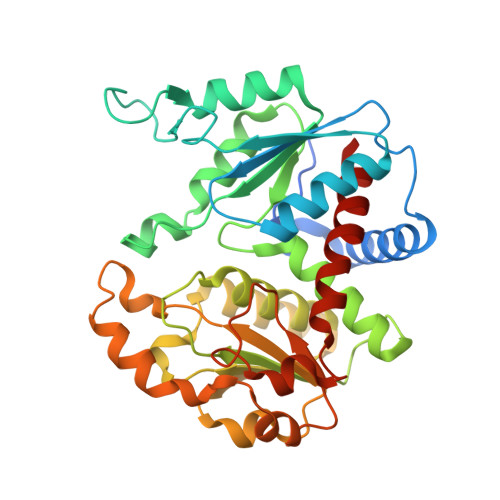Reversible post-translational carboxylation modulates the enzymatic activity of N-acetyl-L-ornithine transcarbamylase.
Li, Y., Yu, X., Ho, J., Fushman, D., Allewell, N.M., Tuchman, M., Shi, D.(2010) Biochemistry 49: 6887-6895
- PubMed: 20695527
- DOI: https://doi.org/10.1021/bi1007386
- Primary Citation of Related Structures:
3M4J, 3M4N, 3M5C, 3M5D - PubMed Abstract:
N-Acetyl-l-ornithine transcarbamylase (AOTCase), rather than ornithine transcarbamylase (OTCase), is the essential carbamylase enzyme in the arginine biosynthesis of several plant and human pathogens. The specificity of this unique enzyme provides a potential target for controlling the spread of these pathogens. Recently, several crystal structures of AOTCase from Xanthomonas campestris (xc) have been determined. In these structures, an unexplained electron density at the tip of the Lys302 side chain was observed. Using (13)C NMR spectroscopy, we show herein that Lys302 is post-translationally carboxylated. The structure of wild-type AOTCase in a complex with the bisubstrate analogue N(delta)-(phosphonoacetyl)-N(alpha)-acetyl-l-ornithine (PALAO) indicates that the carboxyl group on Lys302 forms a strong hydrogen bonding network with surrounding active site residues, Lys252, Ser253, His293, and Glu92 from the adjacent subunit either directly or via a water molecule. Furthermore, the carboxyl group is involved in binding N-acetyl-l-ornithine via a water molecule. Activity assays with the wild-type enzyme and several mutants demonstrate that the post-translational modification of lysine 302 has an important role in catalysis.
Organizational Affiliation:
Research Center for Genetic Medicine and Department of Integrative Systems Biology, Children's National Medical Center, The George Washington University, Washington, DC 20010, USA.
















